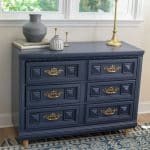80's dresser makeover - Complete guide with pictures
Check out this DIY 80s dresser makeover giving this old oak lowboy chest of drawers a new modern, restyled look.
Materials
Instructions
- Mix the TSP per the directions. Spray the piece using a spray bottle or a cloth dipped in the solution, and wipe it down. Follow the safety directions regarding applying all chemicals. Use a dry towel to ensure the piece is dry and no streaks of grime or grease are left behind.
- Tip: Vacuum the inside of drawers and wipe them down. Adding a cabinet liner or a wood conditioning product is a nice touch.
- Use sandpaper or an electric sander (120 - 150 grit) to scuff sand the entire piece. This will give the primer a rough surface to help adhesion and bonding to the wood.
- Repair any drawer issues. I had to replace two slides that were cracked and loose.
- A Bar of soap or beeswax is excellent for lubricating drawer slides. Rub the bar of soap or a rag with beeswax along all parts of the drawer that comes into contact with a slide or rail on the dresser box.
- Find any imperfections that you want to repair. Use wood filler or Bondo to repair dents / dings, chips, corners, or gouges. Spread the compound with a putty knife along the area needing repair. Allow time to dry and lightly sand with 220 grit sandpaper.
- Apply Zinsser BIN shellac primer to the scuff-sanded 80s dresser. I used a 6" foam roller and a 2' angled paintbrush for the entire piece.
- With a paint sprayer, spray three coats of Benjamin Moore Hale Navy paint in satin finish. Remember, your goal is not to finish by spraying the entire piece with one coat. A paint sprayer takes many thinner coats of paint.
- Apply three coats of Minwax Polycrylic in satin to seal the entire piece of furniture. I used a paint sprayer to ensure no brush strokes. Between each coat, sand with 220 sandpaper. After the third coat has dried, give it a final sand with 600 grit sandpaper if there are any imperfections in the finish.s
- Boil the original, dirty hardware in a mixture of one part water to one part vinegar. Let boil for twenty to thirty minutes before removing to cool. Wipe the hardware with steel wool making sure to get in all of the cracks and crevices. Rinse and let hardware dry. Install refreshed hardware.
